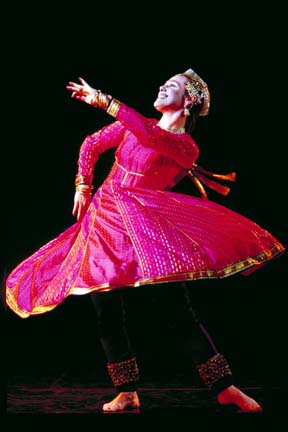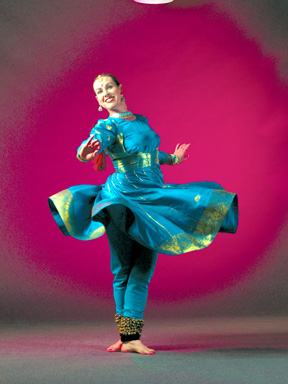Charlotte Morago
Charlotte
Morago
An Evening
of North Indian Classical Music and Dance
ODC Theater
San Francisco, California
May 26, 2004
By
Rita Felciano
Copyright
© 2004 by Rita Felciano
published May 31, 2004
 In
the Western way of thinking, classical dance and improvisation do not
easily cohabit. We have difficulty wrapping our minds around such concepts
as freedom and spontaneity in the context of highly formal values.
In
the Western way of thinking, classical dance and improvisation do not
easily cohabit. We have difficulty wrapping our minds around such concepts
as freedom and spontaneity in the context of highly formal values.
This is but one reason why Kathak dancer, and member of the Chitresh Das Dance Company, Charlotte Moraga’s concert was such a wondrous occasion. Not only did it illustrate how existing frameworks, formal constraints and the weight of tradition need not impinge on personal expression, it also showed how exhilarating playing with the unknown within the known can be.
Moraga performed on the first half of a program shared with sarod player Debojyoti Bose. The Florida-born former jazz dancer, became hooked on Kathak when a Flamenco class she tried to enroll in college was full, and she opted instead for a slot in Das’ Kathak class. That was twelve years ago.
Moraga has become a formidable technician who keeps the recitations, movements and percussive footwork in constantly shifting yet perfectly balanced equilibrium. Yet as a performer she mesmerizes even more because her presentations are so infused with the excitement of discovery and the evident joy she experiences at the ever changing play between the musicians and the dancer. One wonders to what extent the kind of interactions that jazz musicians have with each other, influenced the sense of freedom within discipline that Moraga brings to her performing.
To this excellent dancer the challenge of finding the permutations possible by dividing repeated 16 beat phrases into three equal parts, and coming out at the end exactly on the beat with the musicians, looked like fun. And the audience, who repeatedly showed its appreciation with spontaneous applause, seemed to agree. Rarely have I seen such technically complex, crystalline dancing performed with such abandon.
In ballet, we often talk about how a great dancer becomes part of the music or dances inside the music. For the Kathak dancer, and Moraga is an excellent example, this is literally true. In Kathak the vocalizing and myriad sound of the feet make the Kathak dancer a musician separate and yet integral to the formal body of musicians. And in her body movement, sound and rhythm become part of a continuum where one cannot exist without the other.
The concert, in which Moraga was performing with Kousi Sen on tabla and vocalist Abhijit Berjes also on tabla and harmonium, was of a type once common in India, but apparently becoming rarer these days. As Moraga explained, more and more of Kathak is choreographed, and what we would call “jam sessions” are not nearly as common as they used to be. “For this concert,” she explained, “I was not allowed to rehearse with the musicians.”
And yet it is the risk taking, the challenging of each other which can make Kathak so exciting to watch. If there was a sense of competition between Moraga and these musicians, it was a playful one where both tried to see whether they could throw the other off track but both also delighted in not succeeding. More so than I have seen in some other Kathak concerts, Moraga directed movements towards the musicians. It seemed like a gesture of courtesy, probably indicating which way she was going to go with her next section. They in turn accentuated their drumming during certain passages, allowing her to regroup or catch her breath. Particularly touching was the opening prayer in which Banerjee gently joined Moraga’s humming, gradually increasing his vocalizing until what had been an accompaniment became a duet.
 The
first part of Moraga’s concert was given over to non-narrative dancing
in which she established the tala (pattern of the beats) and the piece
evolved from that structure. Wonderful from a pure movement perspective
was to see tremors produced by blurring footwork travel up Moraga’s
torso. Or simply watch the right foot’s complex response to the
left foot’s regular beat. Or observe the largeness of the arm movements
in contrast with that of the feet. Or get in tune with the dance’s
essential symmetry. At one point a series of single and double pirouettes
projected her into a manege of whipping pirouettes every bit as breath
taking as those seen on ballet stages.
The
first part of Moraga’s concert was given over to non-narrative dancing
in which she established the tala (pattern of the beats) and the piece
evolved from that structure. Wonderful from a pure movement perspective
was to see tremors produced by blurring footwork travel up Moraga’s
torso. Or simply watch the right foot’s complex response to the
left foot’s regular beat. Or observe the largeness of the arm movements
in contrast with that of the feet. Or get in tune with the dance’s
essential symmetry. At one point a series of single and double pirouettes
projected her into a manege of whipping pirouettes every bit as breath
taking as those seen on ballet stages.
Despite the highly formal dancing, the concert, performed in the intimate ODC Theater, had a pleasant informal quality to it, with Moraga giving short introductions to each piece, and tabla player Banerjee at one point complimenting Moraga on a just finished one. When she clearly needed a break to catch her breath, explaining that at the last minute she had decided to substitute a very fast for what had been intended a more slowly danced section, she invited the two tabla players to challenge each other. Which they did to the audience’s great delight.
Closing her half of the evening was a narrative work, about the jealousy between Indra and Krishna. First telling the story—which closely resembles the one from Old Testament’s about Noah’s Arch—and illustrating it with some of the mudras, Moraga could fully engage her expressive and character-dancing capabilities in bringing to life not only an angry Indra, a supreme Krishna, a mortal’s trying to save her children, but also rain falling, falling, falling.
Originally
published:
www.danceviewtimes.com
Volume 2, Number 20
May 31, 2004
Copyright ©2004 by Rita Felciano
|
|